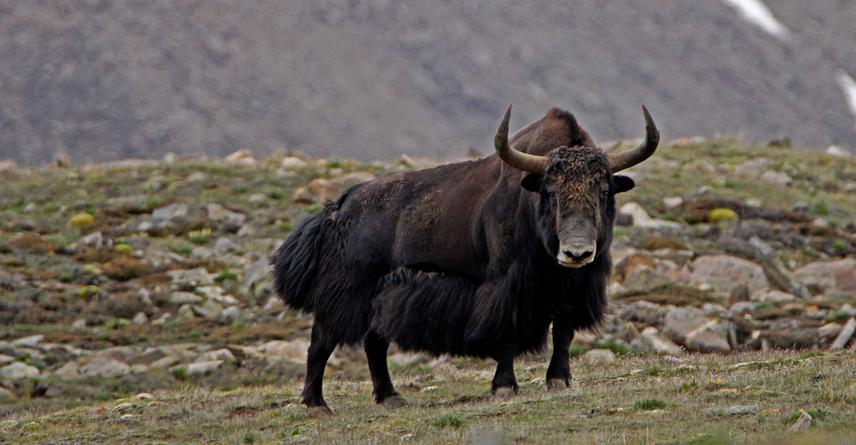Article featuring the project.
The Kathmandu Post - Black giants
26 Mar 2015 Limi, Nepal, Indian Sub-continent Mammals
Establishing the First Population Estimate for Wild Yaks in Nepal and Strengthening Efforts for their Conservation Following the Rediscovery
Performing Genetic Analyses of Wild Yaks in Nepal, Investigating their Hybridization with Domestic Yaks and Producing Additional Conservation Materials
The project aims to assess the population status of wild yak in upper Humla, Nepal and draw attention of the local people, academia and the wildlife policy-makers towards conservation of wild yak in Nepal.

Wild yak in Gyau Khola.
Wild yak is classified by IUCN as globally vulnerable and 'Regionally Extinct' in Nepal. The national red list of Nepal has also assessed it as 'Data Deficient' and 'Possibly Regionally Extinct'. Different evidences (skins, horns) of this species have been reported sporadically in different parts of the higher Himalayas in the country. However, no studies have been made to confirm the authenticity of those observations.
During an informal discussion with the local people of upper Humla in 2008, presence of 'wild yak' was suggested in the remote valleys of the region. In 2013, during a research expedition on snow leopard, Friends of Nature (FON) Nepal recorded fresh hoof marks and dung pile of wild yak in the area. Recently in 2014, our team made live sighting of the species at two different locations in the area. National and international experts have confirmed the sighted animals to be wild yaks after carefully studying the photographs and video footage we collected. The population of wild yak in the area appears very small. Threats to the species prevalent in the area include killing by local people for meat, illegal trade to China and hybridization with domestic yaks. Looking at the small population, these threats are likely to be more pronounced which can lead to total extirpation of the species from the area in a short span of time. Hence, this study has been proposed to assess the population status of the species in the area and to sensitize the local communities about the issue.
The findings of the research will provide an important baseline data on population status and distribution hot spots of wild yak in the area. This will be an important output which could be referred to for carrying out conservation initiatives for the species in the coming years. The conservation camps for the students and the local community of the area will spread the important message about the need of wild yak conservation. This will in turn make way for the long term survival of the species in the region. Conservation materials like posters will sensitize the local people towards wild yak conservation. At the same time, the conservation workshop in the capital city will draw the attention of the conservation stakeholders while the coverage of the event by journalists from the national media will help in advocating the issue of wild yak conservation to a larger mass.
Article featuring the project.
The Kathmandu Post - Black giants